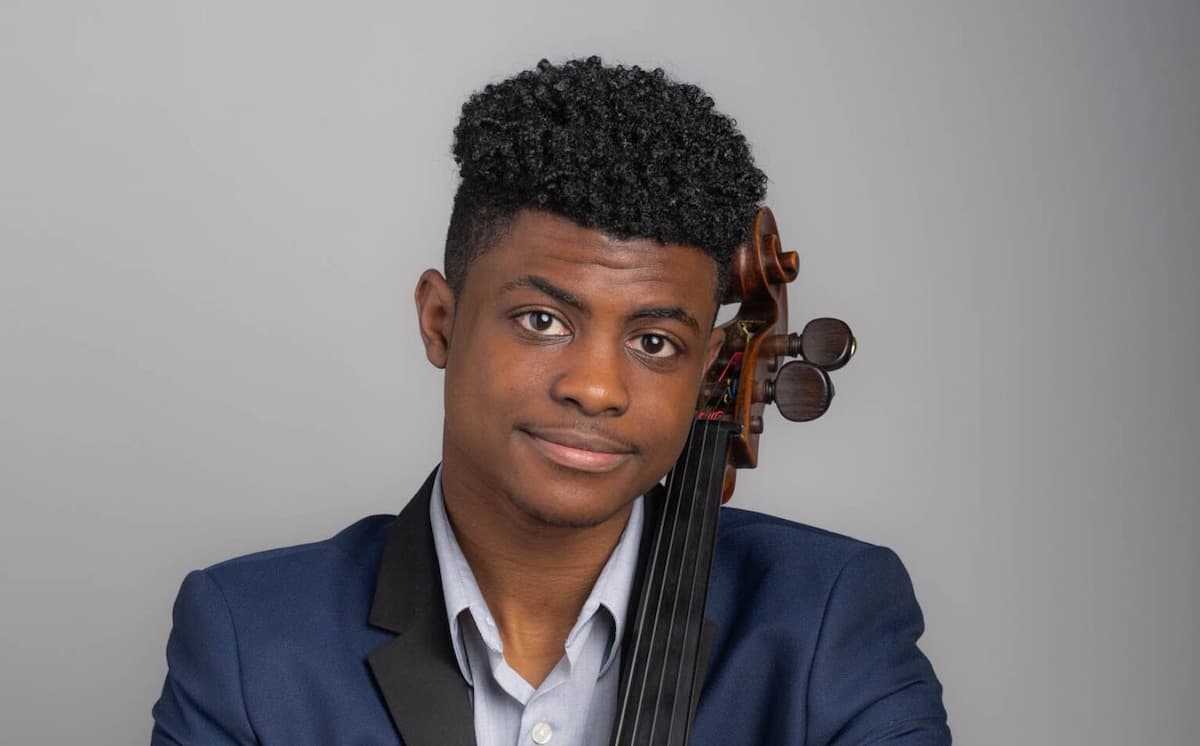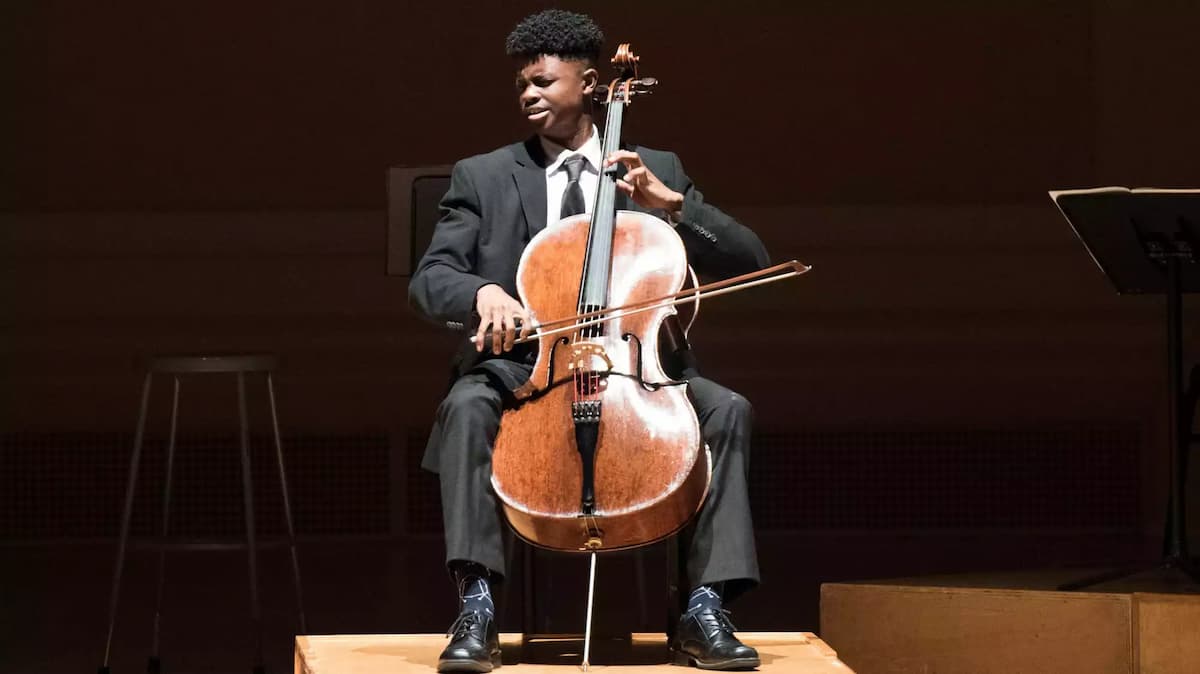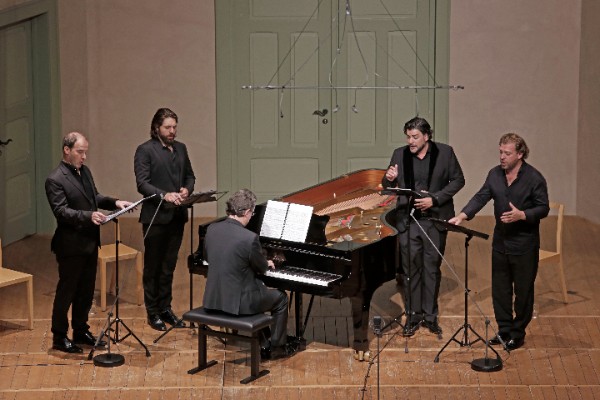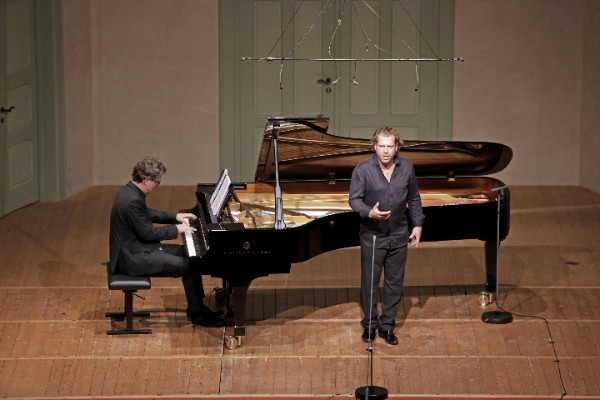In April, 24-year-old cellist Sterling Elliott appeared with the Minnesota Orchestra performing Tchaikovsky’s Variations on a Rococo Theme Op. 33 for Cello and Orchestra. A top award winner of the Senior Division of the 2019 National Sphinx Competition and having recently won a 2021 Avery Fisher Career Grant, he’s made several appearances with top orchestras in the country. I was eagerly anticipating his debut. When he walked out onto the stage exuding confidence and with a welcoming smile, I knew we’d be in for a treat.

Sterling Elliott © sterlingelliott.com
A good friend of the composer, cellist Wilhelm Fitzenhagen, professor of the Imperial Conservatory in Moscow, commissioned Tchaikovsky to write a work for cello and orchestra. Rococo Variations was composed in 1876. Fitzenhagen, a sometime composer, rewrote the work while Tchaikovsky was in the throes of tremendous personal problems—a disastrous marriage, forsaking his wife and fleeing to Switzerland. The piece was published in this revised version. Although it is the preferred version performed today, some cellists, such as Johannes Moser, do play the original. You’ll find the ending is quite different!
Pyotr Ilyich Tchaikovsky: Variations on a Rococo Theme in A Major, Op. 33 – Variation 8 and Coda: Allegro moderato con anima (Johannes Moser, cello; Swiss Romande Orchestra; Andrew Manze, cond.)
Rococo Variations opens with a gentle theme inspired by Mozart, whom Tchaikovsky greatly admired. It requires a delicate and elegant touch and a sweet sound. Elliott didn’t disappoint. His rendition of the rococo theme was the epidemy of grace. The original version has eight variations, but this one performed by Elliott has seven, which follow— some virtuosic, some lyrical, requiring the cellist to quickly don several divergent hats, adopting multiple personalities—while maintaining the exquisite charm of the theme. Each variation connects with a short bridge.
The first variation Tempo della Thema is a triplet figure that is tricky to negotiate while maintaining the lightness and poise of the theme. And I must say it’s in an awkward range of the cello. But not only that, the passage features two notes slurred (in one bow) followed by one note staccato, which is for many players a tricky bowing. In the video of the entire work below, Elliott first plays it starting upbow with the single note downbow (which is backwards to what a lot of cellists do) and when the phrase returns, he reverses it, playing it with the slurred notes downbow and the single note upbow. Very difficult to do! Elliott performed it with panache.
The second variation has long and quick staccato scales which some of us play in one bow, depending on how well we can execute this difficult bow stroke— either all upbow or all downbow, or a combination. But today, more cellists play the notes with separate bows as did Elliott. It’s over in a flash.

© sterlingelliott.com
Tchaikovsky connects to the next more subtle variation by expanding on the connecting passages. The Andante Sostenuto, a slow tempo in three, tender and singing, exemplifies Tchaikovsky’s gift for gorgeous melodies. As the variation progresses, the drama increases, becoming even more eloquent. Elliott played with a luscious tone, great tenderness, and beautiful expressivity.
The Andante grazioso variation begins almost flirtatiously, punctuated simply by the strings. Then there are several rhythmically free passages: rapid scales traveling way up in the register, into very high harmonic notes at the end of the fingerboard, and then back down in a glissando. Despite the technical demands, the variation must be graceful and light. Elliott made it seem effortless.
A variation in trills follows. During the Allegro moderato, the cello moves into a short cadenza featuring trills that leap around the cello into several different registers, but he undertook the vaults fearlessly, fashioning almost birdlike twitters.
The piece moves into a dramatic and passionate cadenza full of dynamic chords, pizzicato, fast notes, and glissando. Elliott took his time with the chords as well as the silences between them, enhancing the drama and storytelling. Listen for yourself courtesy of the Minnesota Orchestra.
Sterling Elliott and the Minnesota Orchestra: Tchaikovsky’s Variations on a Rococo Theme
A melancholy mood connects us to the slower and heartrending Andante movement. With an accompaniment of pizzicato strings and plaintive clarinet interjections, it’s exquisitely written. Elliott played with a deep, full-throated sound, and when the variation fades out with syncopated heartbeats on a low D in the cello ascending again to high harmonic notes, it was dreamy and beautiful.
The last variation Coda-Allegro vivo is a virtuosic movement mostly in spiccato (very fast back and forth notes.) It’s virtually a contest between the solo cello and the strings and flute, which answer the cello in quick quips. As we near the end of the piece, the tempo increases and launches into a breathtaking and difficult octave passage. With his lovely, long, and flexible fingers, he negotiates the difficulties with flair while always maintaining the delicacy of the Rococo style.
Sterling Elliott is a rising star with not only wonderful cello prowess, but also a charming personality. Thankfully, the support of the Sphinx Organization has allowed him and other great artists to flourish. I expect and hope we will be hearing much more about him.
For more of the best in classical music, sign up for our E-Newsletter
Tchaikovsky : Rococo Variations with Sterling Elliott
Sterling Elliott Plays Rachmaninoff’s Vocalise
Interview about his Gagliano Cello
Interview with Fred Childs
Another Sphinx artist Xavier Foley


